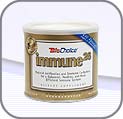Protect
Your
Health with Thieves Oil
Protect and Support Your Brain

Double Your
Energy...
Banish
Disease
 Support
Your Immune System with Immune26
Support
Your Immune System with Immune26
MarketingScents

OilDrops
Business Ideas
| Myrrh, fragrant
resin with ancient heritage, may bear anti-cancer agents
December 06, 2001 NEW BRUNSWICK, NJ—Researchers have identified a compound in myrrh, a bitter-tasting, fragrant resin has been used for thousands of years as an ointment, perfume, incense and embalming fluid, that they believe could be developed into a potent anticancer agent. The compound, which kills cancer cells in the laboratory, shows particular promise for the prevention and treatment of breast and prostate cancer, according to the researchers. The finding is the first to identify an anticancer compound in myrrh, they say. It appears in the current (Nov. 26) print edition of the Journal of Natural Products, a peer-reviewed journal of the American Chemical Society, the world's largest scientific society. It was published in the Web version of the journal on Oct. 25. "It's a very exciting discovery," says Mohamed M. Rafi, Ph.D., one of the co-researchers in the study and an assistant professor in the department of food science at Rutgers University in New Brunswick, New Jersey. "I'm optimistic that this compound can be developed into an anticancer drug," he says. The researcher cautions that the compound has not yet been tested in animals or humans. As part of a larger search for anticancer compounds from plants, the researchers obtained extracts from a particular species of myrrh plant (Commiphora myrrha) and tested it against a human breast tumor cell line (MCF-7) known to be resistant to anticancer drugs. Research data indicated that the extract killed all of the cancer cells in laboratory dishes. Further investigations to isolate the active component of the extract found it to be a unique and previously unknown compound belonging to a class called sesquiterpenoids, which are typically found in natural products. Rafi indicated that an increasing number of compounds in this class have been identified as having cytotoxic properties against cancer cell lines, but none has reached the marketing stage. The myrrh compound appears to kill cancer cells by inactivating a specific protein, called Bcl-2, which is overproduced by cancer cells, particularly in the breast and prostate, the researcher says. Overproduction of this protein is believed to promote the growth of cancer cells and make cells more resistant to chemotherapy. As cancer is influenced by many mechanisms, the investigators are now in the process of trying to determine whether the compound also has other mechanisms of inhibitory action against cancer cells. On the basis of initial laboratory tests, the compound does not appear to be as strong as conventional chemotherapy drugs, such as paclitaxel (Taxol®), vinbalstine and vincristine, which are known to be potent cancer killers. These drugs are highly toxic to healthy cells, however, says Rafi. The researcher estimates that the compound tested is 100 times less potent than paclitaxel. The compound appears to fall within the moderate strength range of other recently discovered phytochemicals (isolated from plants), including resveratrol (from grapes), genestein (from soy) lycopene (from tomatoes) and catechins (from tea). The good news is that these compounds all come from food and are unlikely to be toxic to healthy cells, which could mean fewer side effects as a chemotherapy agent, the researcher says. Once the compound is better understood, it's possible that its potency
could eventually be increased, the researcher says, who envisions that it
could be developed as an oral drug. Rafi predicts that there may be other
compounds in myrrh that are more potent than the current anticancer
candidate though yet to be isolated from the plant. Developing any anticancer drug from myrrh may take five to ten years,
says Rafi. Animal studies of the current compound are planned. The
researchers are in the process of filing a patent on the anticancer
compound. Myrrh is the dried resin obtained from one of several trees of the genus Commiphora. The bitter-tasting, fragrant resin is mentioned in the Bible; it was among the gifts reportedly presented by the Three Wise Men to the infant Jesus. As a medicinal compound, it has been used to kill pain, heal wounds and neutralize bad breath. There is some documentation that some ancient civilizations may have even used the plant to combat cancer. If so, the current study represents the first scientific evidence of its effectiveness, the researchers say. Today, myrrh can be found in health food stores as an ingredient in natural toothpaste and mouthwash, where it is used as an alternative to fluoride to fight dental decay. It is also available in capsule form, as a tea, and as an extract. Rutgers’ New Jersey Agricultural Experiment Station and the New Jersey Commission for Science and Technology provided funding for this study.
Rutgers Contact: Michele Hujber American Chemical Society Contact: Beverly Hassell This press release was prepared and released by the American Chemical Society (ACS). It is released by Rutgers with permission of the ACS. The online version of the research paper cited above was initially published Oct. 25 on the journal's Web site. Journalists can arrange access to this site by calling either the American Chemical Society or Cook/NAJES/Rutgers contact person for this release. Mohamed M. Rafi, Ph.D., is an assistant professor in the department of food science at Rutgers University in New Brunswick, N.J. Chi-Tang Ho, Ph.D., is a professor in the department of food science at
the university and lead investigator in the study.
|
